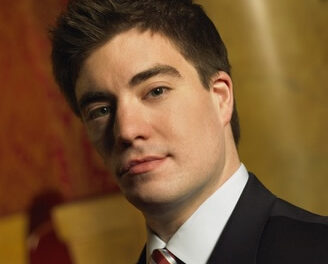The opening performance of the 47th season of the Asheville Symphony Orchestra, marking its third year under the direction of Maestro Daniel Meyer, attracted an excited and appreciative audience to the Thomas Wolfe Auditorium in downtown Asheville. Greeters from the symphony board were in the lobby welcoming audience members, and Meyers himself extended greetings to the audience from the conductor’s podium and introduced the newest orchestra members. After the concert, both he and violin soloist Jennifer Frautschi were in the lobby to greet concertgoers.
Pursuing a theme of colors, both orchestral and visual, the orchestra opened with Rainbow Body (2000) by Christopher Theofanidis, a Greek-American composer from Dallas, Texas, who is a member of the faculty of the Peabody University and the Julliard School of Music. Scored for full orchestra (including a large percussion section), the work was inspired in part by the “Ave Maria, O auctrix vite” (“Hail Mary, source of life” chant of medieval composer and mystic Hildegard von Bingen. Interest in her music has been revived and much of her repertoire has been recorded within the last twenty or so years. Chant motives and longer melodic fragments flashing against contemporary dissonances formed the meditative opening section. The full exposition of the original chant played against pedal tones in the orchestra served as a platform for later development. We heard a true metamorphosis of the chant as it journeyed through changes in mood and harmonic language, utilizing a wide spectrum of the orchestral palette.
Theofanidis has recorded his artistic intentions with this popular piece: “In the orchestration, I try to create a halo around this melody, creating a wet acoustic by emphasizing the lingering reverberations one might hear in a cathedral… Rainbow Body has a very different sensibility from the Hildegard chant, with a structure that is dramatic and developmental, but I hope that it conveys at least a little of my love for the beauty and grace of her work.” While the audience clearly enjoyed the piece, I found myself noticing more the disconnect between the pure, ethereal style of the original chant and the much-later developmental processes in Theofanisis’s piece which, when coupled with modern performance practices (such as the throbbing vibrato in the strings) were stylistic elements reminiscent of modern film scores. Another disappointment was the lack of reverberation in the hall, a key to the success and aesthetic of this work.
The second work on the program was Peter Ilyich Tchaikovsky’s Concerto for Violin in D Major, Op. 35 (1878), with Jennifer Frautschi as the featured soloist. A native of Pasadena, California, Ms. Frautschi attended Harvard, the New England Conservatory, and the Julliard School, and remains active internationally as both a soloist and chamber musician. She performs on a 1722 Stradivarius violin named the “ex-Cadiz.” Tchaikovsky’s (now) beloved violin concerto was written during the turbulent period in which the composer was dissolving his disastrous marriage to Antonina Milyukova. The work was written for violinist Leopold Auer, but, daunted by its new technical demands, he pronounced it “unplayable.” The concerto finally found its champion in Adolf Brodsky, who premiered it in Vienna to an audience unprepared for its musical and technical innovations. The vociferous and influential Viennese critic Eduard Hanslick panned the concerto in unusually strong language (even for him): “Tchaikovsky’s Violin Concerto gives us for the first time the hideous notion that there can be music that stinks to the ear.” By now, of course, there is no question that this music is easily heard and understood, a beloved staple of the concert repertory. Ms. Frautschi aptly demonstrated the enormous concentration, musicality, and physical stamina required to play this giant piece. Such world-class artists immediately put the audience at ease, as these people never seem to miss a note or a nuance. The sheer beauty of her playing was highlighted in the lyrical slow movement where the orchestral ensemble was tight and responsive, notably in the dialogue passages between the principal clarinet (Chip Hill), flute (Young-Joo Yoo), and the soloist.
After intermission the sole work was the Enigma Variations, Op. 36 (1899), the first major work of Sir Edward Elgar. There has been much musing over the nature of the “enigma” — was it the theme itself, the working out of the theme, or some overarching mystery, as yet unexplained? The short theme (seventeen measures) is worked out in fourteen variations that, like character pieces, reveal some personal trait(s) of his close friends. The orchestra performed this piece with finesse and gusto. Several of the variations have tricky beginnings, which were executed cleanly. Kudos to timpanist Todd Mueller (Var. VII), violist Kara Poorbaugh (Var. X), and cellist Brenda Leonard (Var. XII), and Chip Hill (Var. XIII) for outstanding solos. The famous “Nimrod Variation” (Var. IX), so named for the Biblical hunter, was performed as beautifully as I’ve ever heard it.
The Asheville Symphony Orchestra is to be commended in addition for their considerable efforts at education and outreach to the community. Check their excellent website for information on future concerts.













